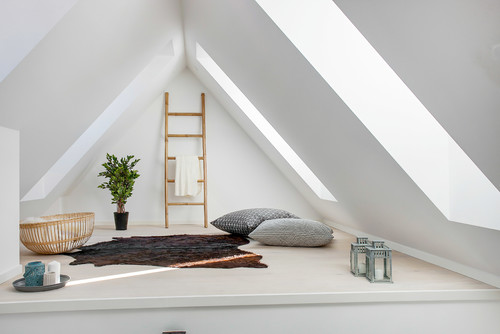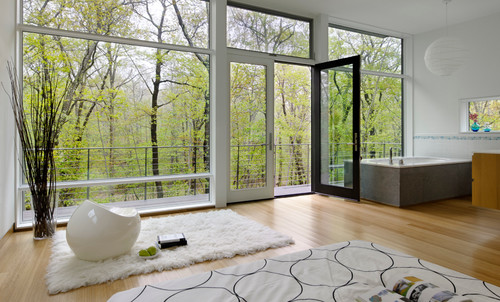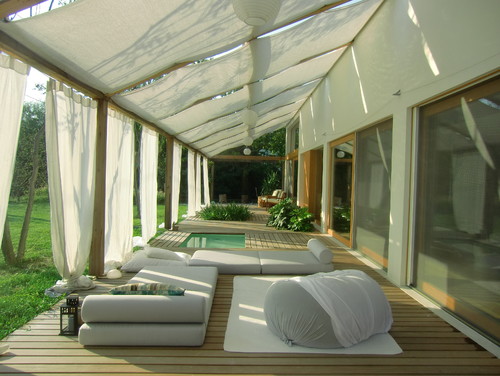
Daily meditation is a healthy exercise that helps you disconnect from the stress of day-to-day life, reduce stress and anxiety, and reconnect with yourself. If you can’t go to a yoga studio every day, home meditation can be a great alternative. Also you can choose to do it alone or be guided by an app. However, your bedroom and living room may not always put you in a calm, meditative mindset, which is why a meditation room can be an excellent addition to your living space.
A guest bedroom, a basement, even a larger storage room can be successfully turned into a serene space for meditation as long as you follow the basic design rules of a meditation room and add elements that create a blissful Zen feeling.
Related: Backyard Rock Garden Ideas | Zen Garden | Types of Home Gym Equipment | Home Gym Ideas | Sauna Dimensions
The core principles of a meditation room
When designing a meditation room, there aren’t any strict guidelines you should stick to and you’re free to add elements that personally inspire you. However, all design elements should meet as much as possible the purpose of such a room: it should be a serene space where you can practice mindfulness and tranquility. According to Anna Filliol, an enlightened living and meditation guide:
“A meditation room should first and foremost be a safe space where there are no distractions. Avoid clutter, over-decorating, and technology. You want to be present in this moment and focus on your meditation.”
Soundproofing
If you live in a big city, street noise can prevent you from reaching a meditative state, which is why soundproofing should be the first thing on your list. Or maybe you live in a bustling home with plenty of children and pets that make a lot of noise and your personal space doesn’t offer you enough peace and quiet. There are several ways to reduce noise levels, depending on your budget and how much time you want to allocate to renovation work:
Insulation
Although insulating your home can be an extensive project, the results are worth it. Sealing the micro-cracks between walls not only reduces noise levels but also increases thermal comfort and helps you save money on energy bills. These insulation materials are recommended for homeowners who want to block street noise:
- Sound-absorbing acoustic foam
- Mineral wool batts
- Acoustic panels
- Floor underlayment
Windows and doors
Noise transfer doesn’t occur only through the walls, but also through the small cracks around windows and doors. Upgrading your windows to double-glazed ones and your door to a model with a high STC rating is the best way to get rid of unwanted noise. However, if you don’t have the budget or you’re looking for a quick fix, these other options can help too:
- Use an insulating sealant around the door and window frames to seal cracks
- Place door gaskets at the jambs and headers of doors
- Place a sound-absorbing door sweep under the door
- Seal windows cracks with acoustic caulk
- Apply weather-stripping tape around your window frames
- Use heavy soundproofing curtains (more on that later!)
Wall color
Colors play an important role in setting the mood in your meditation room. Although every person can react to colors differently, depending on their culture and personal experience, color psychologists outline a few color groups:
- Colors that stimulate, inspire energy and action: red, orange, yellow
- Colors that inspire peace and tranquility and reduce aggression: blue, pastel pink
- Colors that create a sense of safety: indigo, brown
- Colors that create a fresh, natural feeling: green, white
- Colors that can generate anxiety and distress: black, dark grey, crimson red, any excessively saturated shade (such as neon green).
There are no rules set in stone when selecting the color palette for your meditation room. Since this will be a deeply personal space, it’s important to choose a color that resonates with you and that you associate with calm and relaxation. Some people get this feeling from an all-white room. Others think that too much white space reminds them too much of a hospital, so they prefer earthy tones instead.
Eric Kim, the lead painter and decorator at Advanced Painting, explains there are four major themes that can work well for meditation rooms:
- SPA theme: color palettes based on blue, marine shades such as aquamarine, turquoise, dark blue, white, light green, navy.
- Temple theme: inspired by Buddhist and Hindu temples, this theme uses natural earthy shades such as deep brown, tan, green, with minimal additions of red
- Minimalist: if you find colors to be too distracting, you can paint the walls in your meditation room all-white, or choose a subtle color palette based on light shades of ivory and pastels.
- Colorful: if you are inspired by psychedelic shades, then a rainbow theme can be great.
“When choosing the color palette for a meditation room”, he adds, “it’s important to consider not just the way that walls look on their own, but also how everything ties in together after you add furniture and decorations”.
If you’re a beginner to meditation, don’t have specific color preferences, or you’re simply not sure for how long you’ll be using the room, it’s best to stick with a neutral color palette. This way, if you change your mind and decide to use the room for something else, you won’t have to repaint the walls.
Flooring
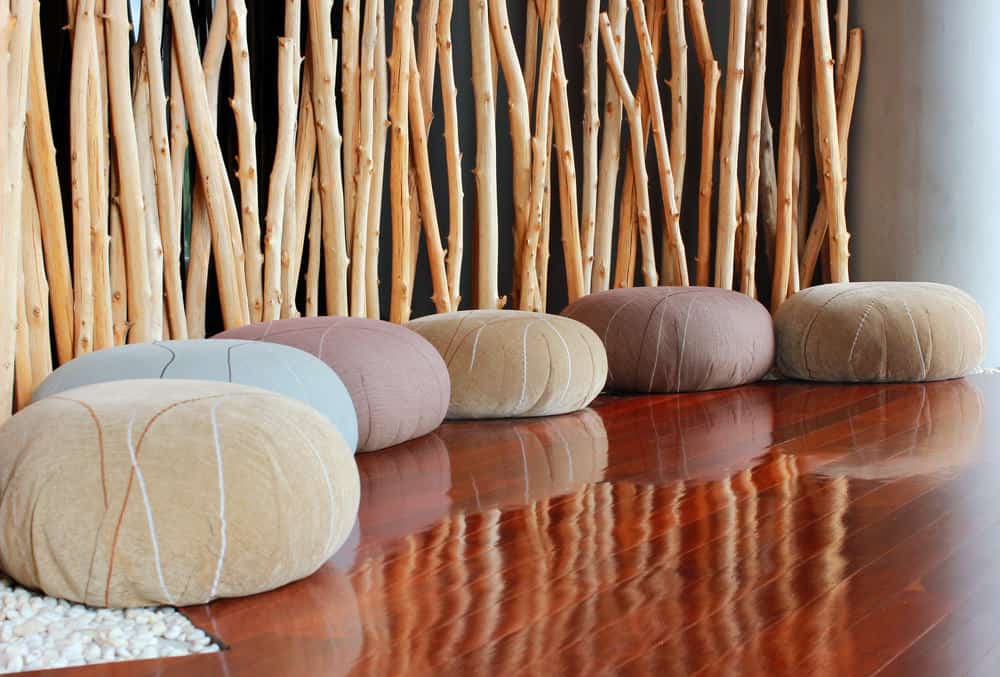
Because yoga and meditation are best done directly on the floor, the type of flooring option you choose will influence your experience. Right off the bat, you can rule out tile flooring. For starters it’s too hard and uncomfortable. Also it attracts cold.
Keep in mind that you will spend a long time on the floor, so you need an option that provides comfort above all. Although laminate flooring may be tempting thanks to its low cost and variety of patterns, it doesn’t quite provide the right energy as natural materials: bamboo and hardwood.
Bamboo flooring
Bamboo is a natural flooring material made from a renewable resource, so if you are worried about the environment, this is a great option for you. Bamboo is also easy to maintain, surprisingly durable, and incredibly stylish.
Hardwood flooring
If you want your meditation room to have a timeless design, hardwood can be an excellent choice. There are many species and styles of hardwood floors, so you can always find something to match your ideal color palette. For example, white oak is excellent for a minimalist theme, while Brazilian Tigerwood matches the earthy tones in a temple-inspired meditation room. Keep in mind that you will be barefoot a lot of the time, so choose a soft or medium-soft hardwood species, such as cherry, walnut, ash, Douglas fir, or birch.
Unfortunately, both bamboo and soft hardwood scratch easily and even if the meditation room won’t be a heavy-traffic area, you’ll still need to apply wax occasionally. Additionally, you can use carpets or rugs to avoid scratches.
Carpeting
Carpeting plays three roles in a meditation room:
- Provides insulation; both thermal (makes the room warmer), and soundproofing
- Increases comfort, so that you can sit on the ground for long periods of time without getting numb
- Adds aesthetic appeal and contributes to the overall design
Just how natural flooring is recommended for a meditation room because it has a different kind of energy, so does natural carpeting. Although carpets made from synthetic fibers are more affordable, they can cause allergic reactions when they come in contact with your skin.
Meanwhile, natural fibers such as wool, seagrass, and jute improve indoor climate, walking comfort, and can even balance humidity in the room. According to a 2015 study, wool carpets can absorb and neutralize contaminants and pollutants such as formaldehyde, Sulfur dioxide, and nitrogen oxides. And you definitely want the quality of indoor air to be as high as possible when doing deep breathing exercises!
In terms of size, you have two option: either you choose one large carpet that covers your floor completely, or you choose one smaller area rug and place it on the spot on the floor where you usually meditate. It all comes down to what makes you comfortable.
As far as color is concerned, neutral shades are the most popular options. For example, the most common carpet color in bedrooms is beige (55%), followed by gray (24%). These are also the most common colors in natural fiber carpets. No matter what theme you’re going for, you can’t go wrong with a neutral carpet, but, if you want your carpet to add a pop of color, you can consider a brighter color or an interesting pattern too. For instance, an ethnic, Indian-inspired rug will look splendid in a temple-themed meditation room.
Pillows & Cushions
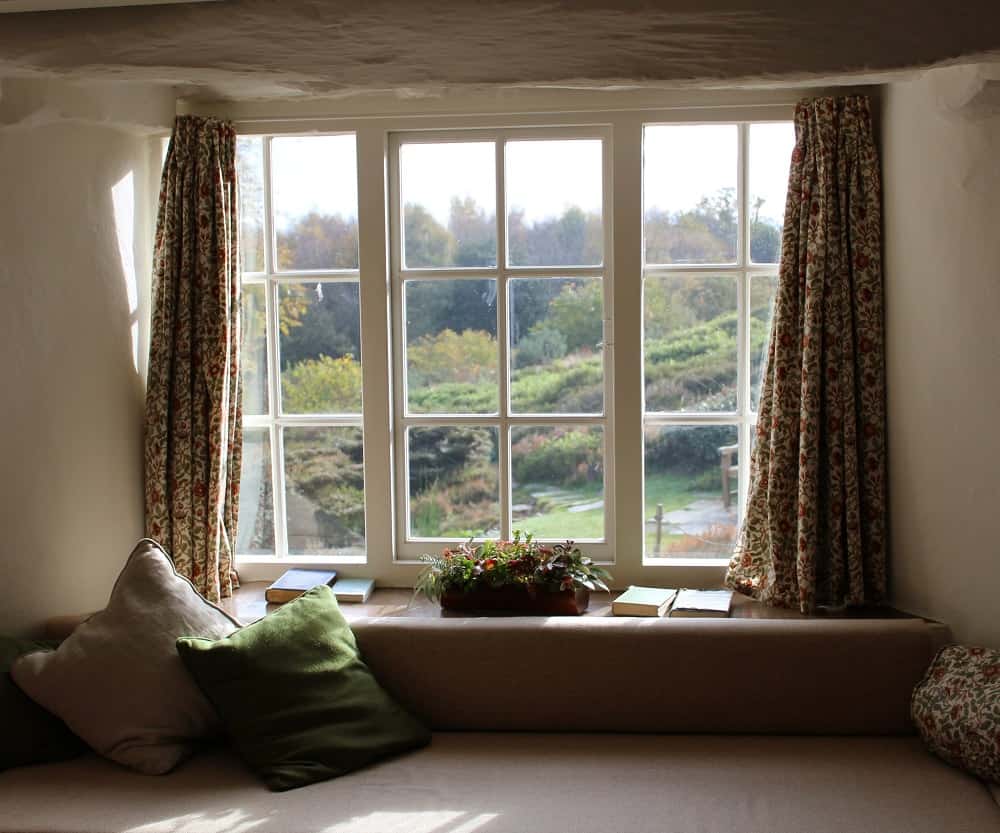
When you first hear about pillows and cushions, aesthetics is probably the first thing that comes to mind. Without a doubt, they are decorative elements that can tie everything together and give your meditation room subtle accents, but pillows matter for so much more than aesthetics.
Pillows and cushions come in several types, shapes, and sizes, and, depending on the activities you plan on doing in your meditation room, you can choose from these options:
Sleeping pillows
This may sound odd, but you can also use your meditation room for sleeping. If you have a busy lifestyle or you are struggling with a sleeping disorder, a power nap in your oasis of peace and quiet, surrounded by scented candles or incense, can be just what you need. For this, you will need the highest quality sleeping pillows.
“A good pillow has to provide enough support to your neck and upper back when you are resting”, explains chiropractor Dr. Michael Courtney, D.C. “Otherwise, you may have a restless sleep, wake up with a stiff neck, and risk serious spine problems as you age.”
The appearance shouldn’t be an important factor when choosing sleeping pillows, and neither should price. Instead, look for a sleeping pillow made from either memory foam or feathers that is neither too hard nor too soft. Finding the best sleeping pillow for you can take some trial and error so it may be best to go in store and try before you buy.
Decorative pillows
As the name suggests, decorative pillows are there just to spice up the room and help you achieve a certain look. Depending on the theme of your meditation space, you can choose from a variety of cute designs and patterns, ranging from minimal to tribal and ethnic styles. Just make sure you don’t go over the top: too many decorative pillows can create clutter and become distracting.
Neckroll pillows
Some meditation exercises involve laying down on your back, which is where neckroll pillows come in handy because they support your neck. If you suffer from acute neck pain, from a recent injury or a pain flare-up, choose a softer pillow. On the other hand, if you are struggling with a chronic neck issue, a harder pillow is recommended.
Meditation cushions
Meditation cushions are cushions you incorporate into yoga and meditation rituals, so you should only buy them from specialized stores. In general, meditation cushions should be hard enough to provide support during your meditation routine, but still soft enough so as not to become uncomfortable. Design options are obviously more limited compared to decorative cushions, and the focus falls more on function and breathable, natural fibers.
Types of lighting

During the day, natural light is the best kind of light. Unless you wanted to create a windowless room on purpose, or you find the semi-darkness created by heavy curtains to be more calming, large, bright windows are the #1 lighting option. Needless to say, exposure to moderate intensity natural light has a number of health benefits.
But, once the sun sets, it’s time to switch to sources of artificial light. In a meditation room, lighting should be calming and relaxing, so avoid harsh fluorescent bulbs or neon lighting. In addition to being bad for the eyes, fluorescent lights also induce a feeling of anxiety, which is the exact opposite of what you need. Natural LED lights are the second-best option, but, if you want to immerse yourself in a magical atmosphere, explore these ambient lighting options instead:
- Scented candles (scents such as sage, lavender, sandalwood, and eucalyptus induce a meditative state)
- Hanging string lights that you can place around the room
- Dimmable lamps that you can adjust depending on the atmosphere you wish to create
Hanging chairs

Don’t worry, hanging chairs aren’t as hard to install as you imagine, so you don’t need to settle for a plain old armchair.
According to Olivia Rassow, editor at Elle Décor, hammocks can add a vacation vibe to your room and help you break away from a boring nine to five routine.
“Ever since I came back from a retreat in Vietnam, I wanted to bring that careless, simple living vibe into my home. So I bought a large hammock chair, which looks positively dreamy and it’s the perfect spot to relax. I can’t think of a better room for a hammock chair than a meditation room.”
These are the three most popular types of indoor hammock chairs you can place in your meditation room:
- Hanging egg chairs
- Hanging basket chairs
- Hammock swings
Tip: Make sure you add a few pillows or soft blankets in your egg or basket chair for a soothing, cocoon feeling.
Most hanging chairs can be easily hung from the ceiling, but if you’re not sure how you can install them, or you want to move the chair from one room to another, there are some models that hang from a stand.
When looking at materials for hammock swings and hanging chairs, choose natural materials such as wood, rattan, and rope.
Windows


If you started an extensive home renovation project and are ready to change some structural aspects about your meditation room, windows are a great place to start because, as we said earlier, natural light is extremely important for your state of mind. Windows are also important for ventilation, which is why yoga studios such as this one have large, open windows.
When it comes to the size of the windows, there are two types of homeowners: those who want as much light as possible and go as far as to replace an entire wall with glass, and those who want to see as little outside activity as possible.
Here are a few windows types that look amazing in meditation rooms (that aren’t single-hung windows):
Awning windows
These windows open on the outside, creating an awning that prevents rain from getting inside. If you want to meditate with your window open, listening to the soothing sound of the rain and not worry about leakage, awning windows are an excellent option.
Bay windows
Bay window sets consist of three parts: one straight, central window and two angled windows on each side. Due to their size, they are recommended for homeowners who want to have a wide view of the outside.
Garden windows
A special type of bay windows that allow you to grow a mini-garden in your room.
Glass block windows
These windows are usually made of frosted glass that lets in all the light, but no visibility. Because of this, they are recommended for rooms where you want a lot of privacy, such as a meditation room.
Picture windows
Recommended for houses with a spectacular view, picture windows are large, transparent frames that occupy up to half of your wall.
Skylights
These windows are placed on the roof, offering you privacy, fresh air, and a fantastic view of the night sky.
When choosing the type of windows for your meditation room, ask yourself these questions:
- What is the view outside the meditation room? Is it a beautiful landscape you’d like to see every day, such as a lush garden or a forest, or is it an uninspiring suburb street?
- How much privacy would you like to have?
- Would you like to install glazed or stained glass on your windows to enjoy the natural lighting, without the privacy issues?
Curtains
Curtains are one of the most versatile elements in your meditation room because they serve three functions:
- They add a beautiful finishing touch to the room and help you get in a relaxed mood
- They add insulation and can be used to soundproof your room
- They add privacy and help you adjust the lighting level depending on the meditation exercise you are doing.
Window specialist Greg Martineau says: “If you know right from the start that privacy is the most important thing for you, then choose heavy, opaque curtains that block sunlight almost entirely, but don’t go as far as to apply a darkening window treatment.”
If you want sunlight and looking at the view from the window, but wouldn’t mind some privacy either, your best balance is to have two rows of curtains: sheer white ones underneath, and opaque ones on top. Read this guide for extensive advice on how to choose the best fabric and thickness for your curtains.
As you probably noticed, we didn’t mention anything about blinds and shades, and that’s because they don’t fit the mood in a meditation room as well as fabric curtains.
Furniture
Last, but not least, we’ve arrived at furniture. This step might seem like the most expensive one but, unlike all the other rooms in your home, the meditation room doesn’t require a lot of furniture. You won’t need any dressers, cupboards, wardrobes, or large tables. On the contrary. A meditation room should be spacious and airy.
Furniture should be minimal, if any at all. Many meditation lovers even find that heavy blocks of furniture block their energy and prevent them from focusing, which is why they only bring the bare minimum, such as a small ground-level table and a chair. Of course, your choice should also depend on the type of meditation exercises you are doing. For example, if you want to create a small shrine, you will need a table, and if you have many books on meditation, you may want to include a small bookcase.
That said, if you like to sit in furniture for meditation, consider a chaise lounge such as following:

Meditation Space Ideas for the Home (Photos)
Conclusion
As is the case with every room in the house, you should consider a few basic guidelines when designing your meditation room, but here you have more freedom compared to other rooms. Most likely you will be the only one using this meditation space. If so, no one should dictate your choices.
Pick the color scheme and decorations that inspire you and make you feel at peace with yourself, experiment and let your imagination play. In the end, this meditation room should be a reflection of your ideal self.



